 Download PDF
Download PDF
Name: Cuscuta epilinum Weihe
Family: Convolvulaceae, the Morning Glory Family
Common Names: flax dodder (4), love-vine, strangle-weed (2)
Etymology: With Arabic origins, Kushkut, means dodder plant or parasitic plant; in New Latin, Cuscuta directly translates as dodder. Epi means upon, on or over in Greek and the Latin linum translates as flax, linen or thread (2,6).
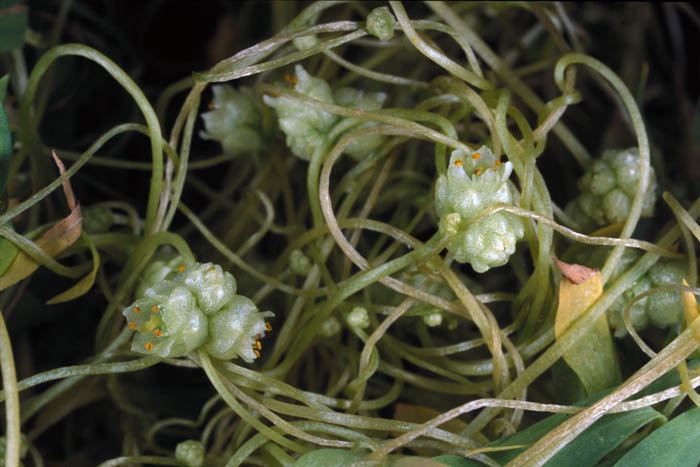 Botanical synonyms: Cuscuta major Koch & Ziz, Cuscuta vulgaris J. Presl & C. Presl (7)
Botanical synonyms: Cuscuta major Koch & Ziz, Cuscuta vulgaris J. Presl & C. Presl (7)
Quick Notable Features:
¬ Simple stem and leaf structure
¬ Twines dextrally or anticlockwise
¬ Most often present in flax (Linum) fields, but also parasitizes jewelweed (Impatiens)
¬ Stems are thread-like (~1.5mm in diameter), yellow-green-cream, forming a fairly dense mass
¬ Tiny flower, ~3mm, with translucent yellowish-white petals, often growing in compact “glomerules”
Plant Height: Cuscuta epilinum’s height depends on the host; the length of a single dodder plant of nearly half a mile was calculated by H.L. Dean in 1942 (18).
Subspecies/varieties recognized: None found in literature.
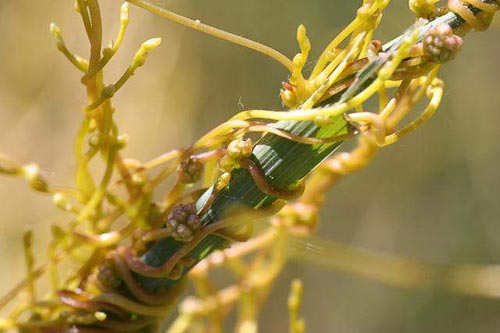 Most Likely Confused with: Any other species of Cuscuta—in Michigan these might be: C. cephalathi, C. coryli, C. epithymum, C. glomerata, C. indecora, C. pentagona, or C. polygonorum
Most Likely Confused with: Any other species of Cuscuta—in Michigan these might be: C. cephalathi, C. coryli, C. epithymum, C. glomerata, C. indecora, C. pentagona, or C. polygonorum
Habitat Preference: Cuscuta epilinum, which occurs naturally on Linum (flax) only, can also parasitize Impatiens (jewelweed) if it is located within its vicinity (10).
Geographic Distribution in Michigan: C. epilinum was cited in 1899 as present in Ingham County, Michigan, although subsequent reports have not been noted (1). Linum, the genus that C. epilinum specifically parasitizes, is evenly distributed throughout Michigan in about half of the counties, so the likelihood of C. epilinum’s presence is high (20).
Known Elevational Distribution: The known altitudinal limit of C. epilinum is 1500m in Spain (24) and the closest relative, C. epithymum (14), is found from 0 to 1500m in California (17).
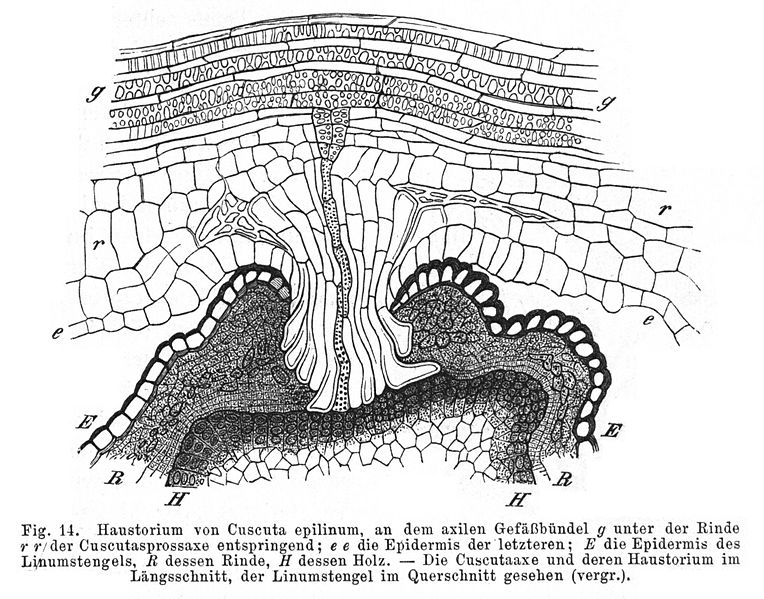 Complete Geographic Distribution: This parasitic vine is now cosmopolitan, however it is native to southwest Asia and Europe. It was introduced to North America from Europe as a seed contaminant; in addition to Washington State, it is mainly found in the mid-west to northeast U.S., including: Maryland, Delaware, Ohio, Pennsylvania, New Jersey, Michigan, New York, Massachusetts, Vermont and the Canadian provinces of Manitoba, Ontario & Québec. It is also widespread throughout Europe (4,10,13,16,19).
Complete Geographic Distribution: This parasitic vine is now cosmopolitan, however it is native to southwest Asia and Europe. It was introduced to North America from Europe as a seed contaminant; in addition to Washington State, it is mainly found in the mid-west to northeast U.S., including: Maryland, Delaware, Ohio, Pennsylvania, New Jersey, Michigan, New York, Massachusetts, Vermont and the Canadian provinces of Manitoba, Ontario & Québec. It is also widespread throughout Europe (4,10,13,16,19).
Parasitism: Parasitism is a type of symbiotic relationship in which plants obtain nutrients directly from another plant. Although parasitic plants are commonly known to lack chlorophyll, some species have green organs, making them partially autotrophic. The physical link between the parasite and the host is called a “haustorium”, and often occurs through xylem-to-xylem attachment. The host can vary, ranging from the mycorrhizae of trees, to grasses and hardwood trees. The parasite often maintains open or partially open stomata, allowing transpiration to aid in extracting nutrients from the host (8).
Vegetative Plant Description: As Cuscuta spp. germinate, they develop a short anchorage root, while a stem forms and nutates (rotates) in search of a host; when an attachment with a host has been created, the anchorage root dies (3). Additional means of finding a host have been suggested in literature, such as, being positively phototrophic or growing toward a source of moisture or specific chemicals (10). In C. epilinum, the stem and leaf structure are simple; the stems are thread-like, yellow-green-cream, ~1.5mm in diameter, and form a fairly dense mass over the host. Any leaf rudiments are alternate. The haustoria of dodders can leave girdle-like swellings on the host, referred to as hypertrophies (10,16).
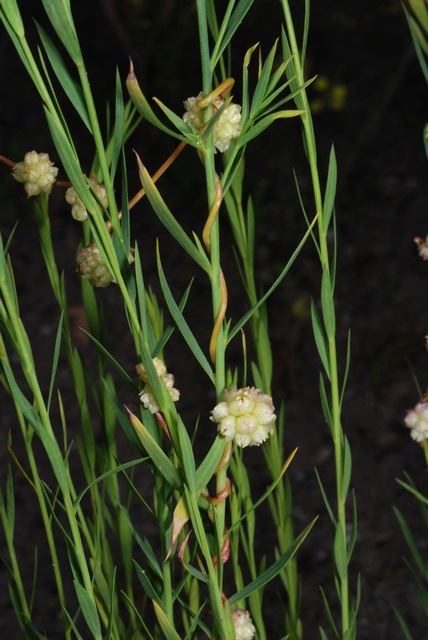 Climbing Mechanism: In the genus Cuscuta, two types of coiling methods are found: loosely twining with few haustoria and tightly twining, with many haustoria—both show upward growth only; it is suggested that the former is used while the plant is in search of a host and the latter is used once contact with a host has been made (10). Haustoria also aid in attachment because they penetrate the tissues of the host. Typically, Cuscuta spp. makes no more than three turns around the same branch. (3). The literature states that the genus generally twines dextrally or anticlockwise (10).
Climbing Mechanism: In the genus Cuscuta, two types of coiling methods are found: loosely twining with few haustoria and tightly twining, with many haustoria—both show upward growth only; it is suggested that the former is used while the plant is in search of a host and the latter is used once contact with a host has been made (10). Haustoria also aid in attachment because they penetrate the tissues of the host. Typically, Cuscuta spp. makes no more than three turns around the same branch. (3). The literature states that the genus generally twines dextrally or anticlockwise (10).
Flower Description: The flowers are tiny, ~3mm long, characteristically sessile, glabrous, and grouped in scattered, compact “glomerules”. Perianth: the calyx is 5-merous, as long as the corolla and has acute, broadly ovate lobes that overlap one another; the corolla is also 5-merous; the lobes are ovate-triangular, obtuse, and shorter than the tube; the lobes are urceolate, imbricate and ascending or adhering to the capsule, with the membranous petals a translucent yellowish-white; staminal scales are spatulate-truncate, and are shorter than the tube—the function of the scales is unknown, but they act as a point of differentiation between species of Cuscuta. Stamens: five epipetalous stamens with anthers ovate-subcordate and about as long as the thin, tapered filaments. Pistils: the stigma is linear-elongate; the styles are separate to connate, forming cavities in between when two or more are present. The ovary is bilocular, and globular. The combined length of the stigma and style is much shorter than the ovary’s length (9,10,13,15).
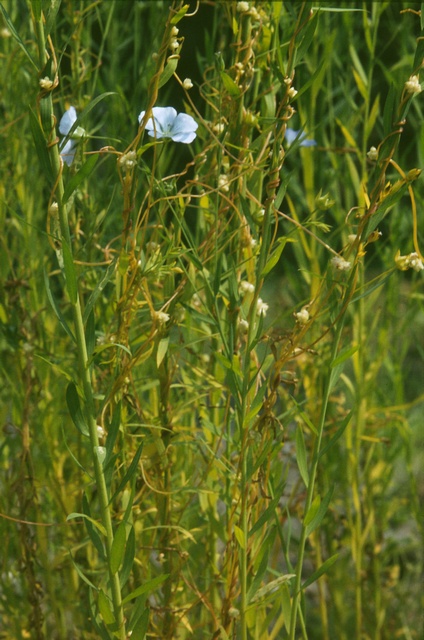 Flowering Time: In Russia, between June and July (16).
Flowering Time: In Russia, between June and July (16).
Pollinator: Within Cuscuta, Yuncker observed visits by wasps and other species of the order Hymenoptera. (15). Specific pollination information on C. epilinum was not found, yet its close relative, C. epithymum has been studied and is summarized here. It was noted that both self-pollination and cross-pollination (most commonly by Crabronidae, Sacrophagidae, Vespidae, and Tachinidae of the orders Hymenoptera and Diptera) are possible. While characterized by small flowers, other means of attracting pollinators, such as secretory cells and modified nectar-producing stomata are present (22).
Fruit Type and Description: The fruit of C. epilinum is compressed and rounded, with a circumscissile line of dehiscence (13,16); its fruits ripen from July to August in Russia (16).
Seed Description: In the genus Cuscuta, the defining characteristic of the mature embryo is the absence of cotyledons. This may make some sense because the first job of the young stem is to search for a host, not to photosynthesize. Each flower has four ovules, but one or more may abort, which causes variation in seed size and shape; a dodder seed may have zero, one, or two flat surfaces (10). In C. epilinum, a mutant double seed sometimes forms, and is proposed as giving aid in the infestation of flax fields in some areas of Europe. Before this morphological change, C. epilinum’s smaller seed size distinguished it from flax, and the two could be separated before planting. However, now the parasite’s seeds are easily missed and sown alongside the crop (11,12). Seedlings can survive without the aid of a host plant for up to 20 days (16).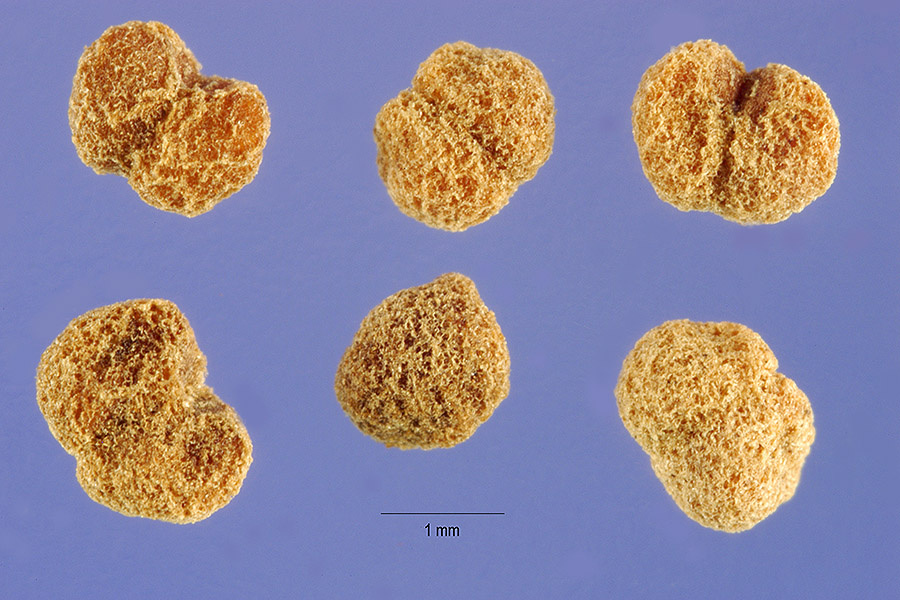
Dispersal Syndrome: Dodder dispersal is recorded as being unspecialized. Since C. epilinum is often seen growing as a creeper around flax plants, the presence of the host is currently a factor in its dispersal. In species of the genus, both germination in the capsule and seeds falling to the ground was observed, leaving water dispersal or other means a possibility for the latter occurrence. Additionally, Cuscuta spp. seeds were indicated as being able to pass through the intestinal tract of a sheep intact, retaining viability; although this specific method of dispersal is unlikely, it extends the potential dispersal methods (3,10,12).
Distinguished by: Close similarities between the vegetative parts of species of dodders, leave one to rely on floral, fruit, and inflorescence characteristics to distinguish among the species (10). C. epilinum is most closely related to C. epithymum (14). They can be distinguished because C. epithymum has triangular calyx lobes, a combined stigma and style length that is longer than the ovary’s length, and an exserted stigma and style. The two species are distinguished from all other Cuscuta species because they open on the circumscissile suture (rather than breaking irregularly) and bear thin stigmas (rather than capitate) (14).
Other members of the family in Michigan (number of species): In Michigan, Convolvulaceae is a small family, comprised of four genera: Ipomoea (4), Convolvulus (1), Calystegia (3) and Cuscuta with 10 species: C. epithymum (L.) L., C. glomerata Choisy, C. Cephalanthi Engelm., C. coryli Engelm., C. polygonorum Engelm., C. gronovii Schultes, C. indecora Choisy, C. pentagona Engelm., C. campestris Yuncker, and C. epilinum Weihe (1).
 Ethnobotanical Uses: While no specific information has been located on the use of this species of Cuscuta, the following information that is not attributed to any one species has been found:
Ethnobotanical Uses: While no specific information has been located on the use of this species of Cuscuta, the following information that is not attributed to any one species has been found:
“An Indian proverb states that the person finding the root of dodder will have access to all the riches of the earth” (10). This statement pertains to the wide use of Cuscuta spp. for medicinal purposes across Asia, from herbal mixtures to treat ovarian cancer and postmenopausal osteoporosis to antifungal and insecticidal applications (23). From another perspective, “The dodder’s rapid development and its stranglehold on and damage to the host have earned it a place in the superstition of many Western countries. The German “Teufelsxwirn” and Dutch “Duivelsnaaigaren” are vernacular names of this sort,” highlights Cuscuta’s standing as a noxious weed in many places (10).
Phylogenetic Information: Convolvulaceae is among 5 other families of the order Solanales (Montiniaceae, Sphenocleaceae, Hydroleaceae, and Solanaceae), which encompasses 165 genera and 4,080 species. The distribution of Convolvulaceae is extensive worldwide, excluding areas of extreme temperatures—the Sahara and Gobi Deserts, and areas of high latitude (Canada, Greenland, Russia, Antarctica, as well as the southern tip of South America). Convolvulaceae has been noted as the only asterid family whose seeds exhibit physical dormancy (5). Cuscuta spp., belonging to the subfamily Cuscutoideae, is the only genus within the family that is parasitic; its placement in Convolvulaceae is open to debate, but is supported by similar flower morphology (10,15, 21).
Interesting Quotation or Other Interesting Factoid not inserted above: Evolutionary changes in seed size, mentioned under ‘Seed Description’, are playing a major role in C. epilinum’s distribution and subsequent treatment as a weed (11,12).
Literature and Websites used:
- Voss, E.G. 2004. Michigan Flora Part III: Dicots Concluded. Ann Arbor, Michigan, USA: Cranbrook Institute of Science.
- Fernald, M. L. 1950. Gray’s Manual of Botany, 8th ed. New York, USA: American Book Company.
- Menninger, E.A. 1970. Flowering Vines of the World. New York, New York, USA: Hearthside Press Incorporated.
- USDA, NRCS. 2008. The PLANTS Database, Version 3.1, National Plant Data Center, Baton Rouge, LA 70874-4490 USA. http://plants.usda.gov/java/profile?symbol=CUEP2
- Stevens, P.F. Angiosperm Phylogeny Website. 2001 onwards. Last modified: January 2011. http://www.mobot.org/mobot/research/apweb/
- Brown, R.W. 1956. Composition of Scientific Words. Washington, D.C., USA: Institution Press.
- Tropicos. Last modified: 2011. http://www.tropicos.org/Name/8500674?tab=synonyms
- Clark, W.D., R. Moore and K.R. Stern. 1995. Botany. Dubuque, Iowa, USA: Wm. C. Brown Publishers.
- Stevens, P.F. Angiosperm Phylogeny Website. 2001 onwards. Last modified: January 2011. http://www.mobot.org/mobot/research/apweb/
- Kuijt, J. 1969. The Biology of Parasitic Flowering Plants. Los Angeles, CA, USA: University of California Press.
- Khalik, K.N.A. 2006. Seed Morphology of Cuscuta L. (Convolvulaceae) in Egypt and its systematic significance. Feddes Reportorium. 117(3-4): 217-224.
- Barrett, S.C.H. 1983. Crop Mimicry in Weeds. Economic Botany. 37(3): 255-282.
- Voss, E.G. 2004. Michigan Flora Part III: Dicots Concluded. Ann Arbor, Michigan, USA: Cranbrook Institute of Science.
- Cooperrider, T.S. 1995. The Dicotyledons of Ohio: Linaceae Through Campanulaceae. Columbus, Ohio, USA: Ohio State University Press.
- Yuncker, T.G. 1920. Revision of the North American and West Indian Species of Cuscuta. Illinois Botanical Monographs. 6(2&3):1-141.
- Larina, S.Y. Interactive Agricultural Ecological Atlas of Russia and Neighboring Countries: Economic Plants and their Diseases, Pests and Weeds. 2003-2009. http://www.agroatlas.ru/en/content/weeds/Cuscuta_epilinum/
- Calflora. Last modified: 2011. http://www.calflora.org/cgibin/species_query.cgi?where-calrecnum=5231
- Dean, H. L. 1942. Total length of stem developed from a single seedling of Cuscuta. Proc. Iowa Acad. Sci. 49: 127–128.
- O’Driscoll C.W. 2003. Preliminary Review of the Genus Cuscuta in North America. North American Plant Protection Organization.
- USDA, NRCS. 2008. The PLANTS Database, Version 3.1, National Plant Data Center, Baton Rouge, LA 70874-4490 USA http://plants.usda.gov/java/county?state_name=Michigan&statefips=26&symbol=LINUM
- Olmstead, R.G and S. Stefanović. 2004. Testing the Phylogenetic Position of a Parasitic Plant (Cuscuta, Convolvulaceae, Asteridae): Bayesian Inference and the Parametric Bootstrap on Data Drawn from Three Genomes. Systematic Biology 53(3): 384-399.
- Meulebrouk, K. 2009. Distribution, demography and metapopulation dynamics of C. epithymum in managed heathlands. Dissertationes de Agricultura. 50-53.
- Costea, M. and T.J. François. 2005. The biology of Canadian weeds. 133. Cuscuta campestris Yuncker, C. gronovii Willd. ex Schult., C. umbrosa Beyr. ex Hook., C. epithymum (L.) L. and C. epilinum Weihe. Canadian Journal of Plant Science. 298.
- Gbif.org. Global Biodiversity Information Facility Website. Accessed: 10 January 2013.
Image Credits (all used with permission):
1) Image of the flower from: http://www.parasiticplants.siu.edu/. “The Parasitic Plant Connection” (Daniel L. Nickrent), Cultivated on Linum usitatissimum in the Pennsylvania State University greenhouse. Photo by Joel McNeal
2) Close view of twining from the Interactive Agricultural Ecological Atlas of Russia and Neighboring Countries. Ultimately retrieved from http://sophy.u-3mrs.fr/Photo-cp/Cro/Cuscuta_epilinum (SOPHY – Une banque de donnees botaniques et ecologiques, website author: Henry Brisse. http://www.agroatlas.ru/en/content/weeds/Cuscuta_epilinum/
3) Drawing of haustoria: Haustorium von Cuscuta epilinum an Linum usitatissimum from Julius Sachs: Vorlesungen über Pflanzenphysiologie, zweite Auflage, Leipzig (1887), downloaded from http://commons.wikimedia.org/wiki/File:Haustorium_Cuscuta_epilinum.jpg
4) Image of C. epilinum twining is courtesy of Biopix.dk http://www.biopix.dk
5) Image of C. epilinum parasitizing flax plants is courtesy of Biopix.dk. http://www.biopix.dk
6) Image of the seed is courtesy of Steve Hurst @ USDA-NRCS PLANTS Database.
7) Mass of Cuscuta epilinum on field from Biodiversity of the Vugrovec Area. Downloaded from http://www.bvo.zadweb.biz.hr/pages/opce/pocetna_stranica_eng.htm”
Primary Author: Lauren S. Sopher, with editing by Robyn J. Burnham
© Robyn J. Burnham
For additional information on Michigan Plant Diversity web pages please contact Robyn J. Burnham via email: rburnham“at”umich.edu